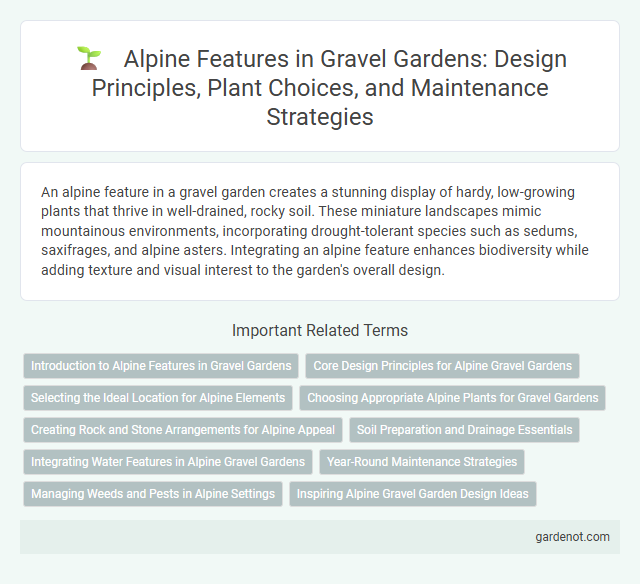An alpine feature in a gravel garden creates a stunning display of hardy, low-growing plants that thrive in well-drained, rocky soil. These miniature landscapes mimic mountainous environments, incorporating drought-tolerant species such as sedums, saxifrages, and alpine asters. Integrating an alpine feature enhances biodiversity while adding texture and visual interest to the garden's overall design.
Introduction to Alpine Features in Gravel Gardens
Alpine features in gravel gardens create a naturalistic and low-maintenance landscape by incorporating small, hardy plants that thrive in rocky, well-drained soils. These features often include miniature rockeries and alpine plants like saxifrages, sedums, and thyme, which are adapted to harsh conditions and require minimal watering. The integration of alpine elements enhances biodiversity and adds year-round texture and color to gravel garden designs.
Core Design Principles for Alpine Gravel Gardens
Core design principles for alpine gravel gardens emphasize well-drained, gritty soil to replicate mountainous habitats and support drought-tolerant alpine plants. Incorporating varied rock sizes and strategic placement enhances naturalistic aesthetics and microclimates essential for species like saxifrage and sedum. High sun exposure and minimal organic matter promote root health and prevent moisture retention, crucial for thriving alpine flora.
Selecting the Ideal Location for Alpine Elements
Choosing the ideal location for alpine elements in a gravel garden requires well-drained soil and full sun exposure for optimal growth. Alpine plants thrive in rocky, elevated areas with minimal moisture retention and excellent air circulation to prevent root rot. Ensuring these conditions supports the unique adaptations of alpine species, enhancing their resilience and visual appeal in the garden.
Choosing Appropriate Alpine Plants for Gravel Gardens
Selecting appropriate alpine plants for gravel gardens involves prioritizing species that thrive in well-drained, rocky soil with minimal water retention. Dwarf sedums, saxifrages, and cushion-forming sempervivums exhibit exceptional drought tolerance and compact growth, making them ideal for these conditions. Incorporating native alpine varieties enhances biodiversity and ensures adaptability to the local climate.
Creating Rock and Stone Arrangements for Alpine Appeal
Crafting rock and stone arrangements in a gravel garden enhances the alpine appeal by mimicking natural mountain landscapes with layered slabs, boulders, and pebbles. Selecting native alpine stones like granite or limestone ensures authenticity and durability under harsh climate conditions. Proper placement creates microhabitats for alpine plants, improving drainage and emphasizing textural contrasts for a visually striking, sustainable garden feature.
Soil Preparation and Drainage Essentials
Gravel gardens with alpine features require well-drained, sandy or gritty soil to mimic mountainous terrain conditions. Soil preparation involves incorporating coarse sand or fine gravel to enhance drainage and prevent waterlogging, crucial for alpine plants' root health. Proper grading ensures water flows away from plant bases, reducing the risk of root rot and promoting vigorous growth in well-aerated soil.
Integrating Water Features in Alpine Gravel Gardens
Integrating water features in alpine gravel gardens enhances the naturalistic appeal while supporting moisture-loving alpine plants such as saxifrage and creeping phlox. Utilizing small cascading streams or shallow basins crafted from natural stone maintains proper drainage and mimics alpine habitats, promoting healthy plant growth. Strategic placement near rock formations ensures the water elements complement the gravel landscape, fostering biodiversity and a tranquil atmosphere.
Year-Round Maintenance Strategies
Alpine features in gravel gardens require year-round maintenance strategies that prioritize soil drainage and frost protection to ensure plant health. Implementing regular inspections and targeted pruning during late winter enhances resilience against harsh weather conditions. Using appropriate mulch layers and adjusting watering schedules seasonally supports thriving alpine plants in diverse climates.
Managing Weeds and Pests in Alpine Settings
Effective management of weeds and pests in alpine gravel gardens relies on selecting hardy, low-maintenance plant species adapted to harsh conditions. Implementing mulching with gravel or small stones helps suppress weed growth by limiting soil exposure and retaining moisture. Regular monitoring and targeted, organic pest control methods maintain plant health without disrupting the delicate alpine ecosystem.
Inspiring Alpine Gravel Garden Design Ideas
Inspiring alpine gravel garden design ideas transform rocky landscapes into serene, low-maintenance sanctuaries by integrating drought-tolerant alpine plants such as sedums, saxifrages, and dwarf conifers. Strategically layering varying gravel tones and textures enhances drainage while mimicking natural mountain terrains, creating visually striking contrasts. Incorporating raised rock beds and natural stone pathways not only emphasizes elevation changes but also supports plant health in alpine conditions.
Alpine feature Infographic

 gardenot.com
gardenot.com